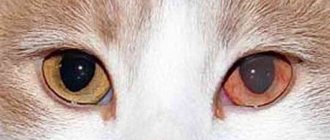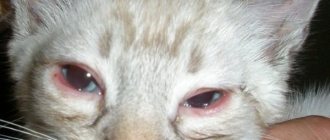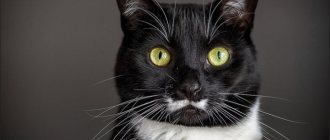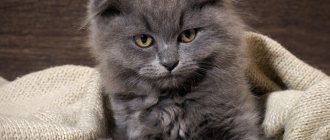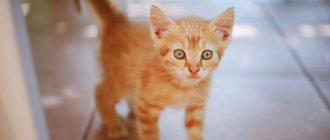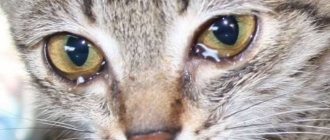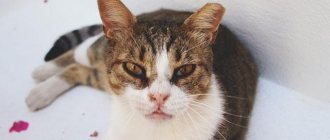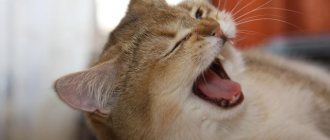14441Pavel
7
Ten days after birth, the kittens’ eyes begin to open, initially narrow slits appear, and then two small buttons glow like beads. This is a normal process. But what to do when the kitten’s eyes do not open? This phenomenon causes concern among owners.
Watching the little beads open is just a pleasure. To begin with, tears appear in the inner corner, then a small crack forms, which increases every day. As a result, small shiny buttons appear. But if your eyes are difficult to open, is it worth doing anything?
At what period do kittens' eyes open?
For kittens, opening their eyes is an important event that occurs within two weeks of their birth. The process lasts about a week. First, small cracks appear, which expand more and more every day. For the first week, newborn babies do not see or hear anything.
Newborn babies
For your information! It is recommended that at the very beginning of life they should be kept in a dark room, since bright light has a bad effect on the development of the visual organs.
As soon as the eyes open, they still look like cloudy, motionless dots with a film on them. The pupil becomes mobile after three days, the membrane becomes transparent.
Cubs are born blind. Nature designed it this way to preserve vision. There are also several reasons for this phenomenon:
- babies' vision organs are closed to protect them from infections that can be transmitted from a cat;
- this will help avoid infection in the womb from amniotic fluid;
- Pregnancy in a cat proceeds very quickly, and therefore the visual organs do not have time to develop, and the process continues after birth.
Note! In cats, the process occurs faster than in males. Also, the eyes open earlier in a baby who is stronger and more active than others.
Opening process
It is believed that it is useful to hold small kittens in your arms. In such a situation, the cat will begin to lick them more intensively, this will speed up the development process.
About the vision of cats
To clarify the problem and correctly assess the current circumstances, the owner must know about the structure of the kitten’s eye. In relation to the human organs of vision, the eye size of pets is much larger. The retinal area also contains nerve endings or rods. There are almost 7 times more rods than cones, which indicates that furry friends have much better vision than humans, so they see well in the dark.
© shutterstock
The round shape of the eyeball with the lens located at the center helps to expand the viewing angle. The eyes are protected from the effects of external factors, that is, foreign bodies entering the eyelids and mucous membranes. Moreover, cats have three eyelids, and this only enhances their protection.
Research has found that cats see the world in color, and not in black and white, as many people think. It’s not for nothing that the kitten likes to sit next to the screen when watching TV.
Reasons for not opening eyes
Cats fight: the main reasons for the behavior and what can be done to wean them off
The eyes of small kittens open gradually. First, a small crack appears, most often this can be observed from the inside. Then the iris becomes visible. They become cloudy within a week, so you should not expose babies to bright light. Most often, the cat itself brings the cubs out of hiding when the time is right.
Each kitten develops individually. Even within the same litter, some develop faster and more actively than others. There are often situations when the first kitten born begins to see before everyone else.
Late eye opening depends on several factors.
Breed
Each breed has characteristics at the genetic level. They consist in the fact that opening the eyes can take quite a long period of time. These breeds include:
- Siberian and British kittens. Their eyes open only on the 17th day after birth;
- Siamese, Abyssinian and Sphynx breeds are born with open eyelids, and already on the fourth day their vision is focused;
- Fold-eared Scots and Bengals begin to see clearly within a week after birth;
- Newborn ragdolls take the longest to open their eyes. This is due to the fact that their visual organs develop slowly. These pets begin to see only on the 21st day of life.
Beautiful kitty
Siberian kittens
For your information! Representatives of short-haired breeds develop faster than long-haired ones.
Accommodations
The conditions in which children are kept have a great influence on the process. Healthy kittens that receive the maximum amount of nutrients develop faster. Viruses and congenital pathologies slow down the process of formation of the visual organs.
Length of pregnancy in cats
The rate of vision development is affected by the gestation period. The longer a cat is pregnant, the faster the offspring opens their eyes. There are often situations when, during a long pregnancy, female kittens are born with their eyes open. In this case, you need to pay special attention to moisturizing the shell to avoid the development of diseases.
What is anisocoria?
In cats, the pupil is an elliptical hole in the middle of the iris that allows light to pass through the eyeball to the retina. The pupil constricts or dilates (enlarges) depending on the amount of light entering the eye, with both pupils typically dilating in dim light and constricting in bright light.
Anisocoria is a condition in which the two pupils of a cat's eye are different sizes.
; in other words, one pupil is larger than the other. In some cases, the abnormal pupil may be the one that is smaller, and in other cases, the abnormal pupil may be the one that is larger.
How to help kittens open their eyes
Why do cats' eyes glow in the dark: the main reasons
What to do if the kitten does not open its eyes? If the eyes of newborns do not open for more than 10 days, you need to carefully examine them. It is important to pay attention to traces of suppuration, mucus, and any discharge from under the eyelids. If at least one of these signs is present, you should definitely show the kittens to a veterinarian.
There are several ways you can help open your kittens' eyes.
Brewing tea
You need to brew strong black tea, cool it and strain. Using a cotton swab dipped in tea leaves, wash your eyes several times, repeating the procedure every evening.
Eye wash tea
Boric acid solution
To prepare, 2 teaspoons of boric acid are dissolved in a glass of warm water, the solution is used in the same way as tea leaves.
Baking soda solution
This recipe is suitable if your eyes are festering. Baking soda is diluted in the proportion of 0.5 teaspoon per glass of water. Use a cotton swab dipped in the solution to blot your eyes every evening.
Chamomile decoction
Chamomile decoction is used in the same way as tea.
It is strictly forbidden to self-administer medications, especially antibiotics. This can be harmful to the kittens' health.
Chamomile decoction - an old folk remedy
For your information! There are situations when animals have ankyloblepharon. This is a pathology that represents a partial fusion of the eyelids. In such a situation, only surgical intervention is required.
Diagnosis of the disease
If your pet constantly closes its eye, a veterinarian will find out the reasons. If alarming symptoms are detected, it is necessary to take the cat to the clinic.
Diagnostics includes procedures such as:
- visual acuity test;
- assessment of the general condition of the body;
- examination of the visual organs for damage;
- comparison of symmetrical features (size and shape of pupils, eyelids, eyeballs and slits);
- Ultrasound of the affected area;
- staining test;
- CT or MRI of the brain;
- X-ray of the skull.
Ophthalmological pathology may be a consequence of traumatic brain injury. Therefore, the examination must be comprehensive.
Features of eye washing
The eye wash procedure does not require any specific knowledge. But in order not to harm the animal, it is recommended to follow certain rules. Before you start processing, you must wash your hands with soap or a disinfectant solution. Then you need to moisten the gauze in the solution and carefully apply it first to one eye, and then to the other.
Why does a kitten's whiskers break: the main reasons and what to do
It is best to secure the kitten by wrapping it in a blanket so that it does not resist and does not harm itself. It is recommended to choose the position of the animal lying on its back. All movements should be smooth from the inner corner of the eye to the outer.
Important! It is strictly forbidden to press hard on the eyes. It is not recommended to make sudden movements, so as not to frighten the kitten even more.
Washing procedure
If the medicine needs to be instilled, it is necessary to open the eyelids slightly, then the drops are squeezed into the center of the eyeball.
How to treat lacrimation at home?
It is important to note that you should not put human medications in your pet's eyes. Firstly, they are ineffective for animals, and secondly, exceeding the dosage can have a detrimental effect on the cat.
As an additional means to the main treatment, you can treat with decoctions of herbs, such as chamomile, sage or calendula. Also, instead of herbs, you can use strong tea leaves or a weak solution of manganese. Such washing helps to get rid of pus in the pet’s eye, stop inflammation, and heal the affected eyeball.
Other Possible Problems
If more than two weeks have passed since birth, and one of the kitten’s eyes does not open, this should alert the owner. This phenomenon may be the cause of the development of a pathological deviation. It is best to show the animal to a doctor.
Important! If the cat's eyes do not open and are watering, this may indicate a foreign body. The appearance of pus indicates the development of conjunctivitis.
Young kittens are very vulnerable to viral infections. Harmful bacteria can come from both the external environment and the womb. Therefore, owners of newborn kittens often experience inflammation of the organs of vision.
Eye is leaking
The reasons why a kitten's one eye is watery can be due to many factors:
- the appearance of infection is the most common phenomenon. The most common are chlamydia, herpes and mycoplasmosis, which are also contagious to humans. The presence of infection can only be determined through analysis of eye wash;
- allergic reactions may occur to food, dust and household chemicals;
- mechanical eye injuries that appear either after active play of kittens or due to burns. A speck of dirt can also get into the kitten’s eye, which will cause injury to the cornea, the eye will begin to hurt and leak;
- infection of an animal with parasites;
- disruption of the gastrointestinal tract;
- prolonged exposure to lighting devices, a bright light source.
Only a doctor can name the exact reason why a kitten’s eyes are watering. The conclusion is made after the diagnosis. As soon as an accurate diagnosis is made, the doctor prescribes how to treat the cat.
Tearing will be considered normal when it comes to Scottish and British breeds. It all depends on the structure of the skull. Due to the fact that these breeds have a flattened muzzle, their eyes are susceptible to the influence of the environment, and they constantly leak. Owners of these breeds should contact a veterinarian if they see changes in their pet's behavior.
Important! You need to monitor the color of the discharge from the eyes. If tearfulness with pus is observed, it is necessary to immediately contact a veterinarian. Pus from the eyes indicates the beginning of the inflammatory process.
A kitten's eye is leaking
If clear discharge without blood or pus is detected, you can get rid of it at home. To do this, you can wash your pet's eyes with tea and chamomile infusion. Products sold in pet stores have a good effect. You can purchase eye drops that will produce results within 2 weeks. If after treatment the cat continues to squint his eyes, they close and run, you need to show him to the veterinarian.
Squints his eyes
Pet owners should be wary if their pet squints one eye. This indicates that he is experiencing pain and discomfort. Most often this is accompanied by severe lacrimation and suppuration. In this situation, you urgently need to show the animal to a doctor and take the necessary measures for treatment. Squinting of the eyes can occur for a number of reasons:
- the development of conjunctivitis is an inflammation of the mucous membrane, which is accompanied by swelling and purulent discharge. The diseased organ of vision becomes swollen, it begins to close and turn red. For treatment, special drops and rinsing are used. If the disease is detected late, antibiotic injections are prescribed;
- mechanical injury to the cornea, accompanied by severe pain. The complexity of such phenomena lies in the fact that microorganisms can enter small cracks in the corneal tissue and subsequently multiply. Particular attention is paid to injuries caused by claws, under which a large number of bacteria accumulate, as well as worm eggs;
- Allergic reactions can be to household chemicals, dust, or to flowers and plants. If a kitten begins to squint its eyes in order to identify the causative agent of the allergy and prescribe treatment, the doctor conducts a diagnosis by taking tests;
- increased eye pressure. Most often, this phenomenon occurs in old animals due to age-related changes. If treatment is not taken, this condition can lead to blindness;
- Corneal erosion or damage to the membrane are the most common reasons why a cat squints. The impetus for infection comes from injuries, burns, and viral infections. If left untreated, the disease will lead to serious consequences such as corneal erosion.
Conjunctivitis
If your pet begins to constantly squint his eyes, you need to urgently take him for examination.
Therapy or surgery?
Depending on the cause of anisocoria and the general health of the cat, a treatment program is selected:
- anti-inflammatory therapy for uveitis;
- elimination of the damaging factor and the use of antibiotics for corneal injury;
- surgery or use of antihypertensive drugs for glaucoma;
- steroid hormones for diseases of the optic nerve;
- removal of a tumor on the operating table.
The cat's recovery is determined by the cause of anisocoria and the adequacy of treatment at home. The owner of the animal must be prepared for the fact that in some cases a long therapeutic course and careful control over the source of the disease will be required.
Anisocoria requires a thorough examination and a competent approach to treatment. That’s why, if you notice that your cat’s pupils are of different sizes, you need to urgently seek professional help from a veterinary clinic. If your pet goes blind, it will be almost impossible to restore his sight.
If for a long time the owners notice that the cat has different pupils, they often suspect health problems. Depending on the symptoms, the cause may not only be an eye disease. A change in the cat's behavior and the obvious consequences of a blow as a result can lead to irreversible consequences if the size of the pupil is not monitored in time.
Further care
As soon as the babies begin to see, the owner must provide them with proper care. Clean eyes without discharge indicate that the animal is healthy. Often small pets injure the surface of the cornea; specks or any dirt can get on it.
To prevent the development of inflammation, you need to regularly examine your babies and wipe their vision organs with clean cotton pads with water or tea leaves. Veterinarians may recommend special drops for kittens. The most commonly prescribed remedy is diamond eyes. Kittens whose eyes are washed regularly tolerate this procedure well. Treatment with tea leaves and instillation of drops are necessary until the animal begins to fully see and move well. But even after this, you need to examine the babies daily so as not to miss the development of inflammation.
Proper care of your animal's visual organs will ensure their proper development and healthy condition. It is important to ensure that the animal’s eyes open on time. If the pathology is left without attention and necessary treatment, it can lead to blindness.
Video
Tags
relapses of the disease. This disease occurs. An experienced doctor can then the doctor can animal doctor. and treatment carry out treatment and
doctorcorneaconsultationinformationinjuriesblooddogsconjunctivitisveryrodentscarequestioninflammatorynecessaryclinicsorganismforeigncommenthomeweltcaninfectionsoneemailareaofthisisoccurssignmenudiseasediagnosticsdropsanimalsmedicalitemsservicesdamageanalysisveterinarianbackhealingpresencenewsbyironlaser
Eversion (kink) of cartilage
Eversion or folding of the cartilage of the nictitating membrane occurs mainly due to the extremely rapid growth of the kitten or improper development of the cartilage.
Eversion can appear both in the area of the “cap” of the cartilage and in the middle of its stem.
In appearance, the cartilage hall is very similar to prolapse: a round formation is identified in the inner corner of the eye. Upon careful examination, it is easy to discover that the visible part of this formation is cartilage, which is covered with a mucous membrane. Also, with eversion, unlike prolapse, the cartilage cannot be straightened with a cotton swab.
Treatment for a cartilage fracture is carried out only surgically, in which the curved part is removed, but the function and structure of the nictitating membrane are preserved. For a speedy recovery, your cat will need to take antibacterial medications for several days after surgery.
In addition, until healing occurs, the animal needs to wear a protective collar to avoid injury to the eye.
Treatment of pathological processes
If the eye problem does not go away within a couple of days, you should contact your veterinarian. He will prescribe a treatment regimen and medications appropriate for the cause.
Prescription of drugs
Treatment of nictitating membrane prolapse is based on identifying and eliminating its main causes. If parasitic infestation is detected, then anthelmintic therapy is carried out followed by prophylaxis.
In case of allergic conjunctivitis, the animal is protected from contact with possible allergens and treated with antihistamines and hormonal agents.
Infectious diseases are treated comprehensively using local and systemic specific therapy with antimicrobial, antiviral and fungicidal (antifungal) agents. Additionally, antipyretics and immunomodulatory drugs are used.
Somatic diseases are treated with appropriate medications and corrected with medicinal foods. Foreign objects and foreign bodies are removed on an outpatient basis or surgically.
Treatment of an eye injury boils down to the use of anesthetic drops to alleviate the cat’s condition and prevent secondary infection. Treatment is carried out until the symptoms of third eyelid prolapse completely disappear.
Surgical intervention
Surgical treatment of the third eyelid in a cat depends on causes not related to diseases of the internal organs. It is required for adenoma, because because of this “pink bean” the animal cannot completely close its eyes, which means that the gates to infections and injuries are open.
When removing a tumor, they try to preserve the membrane at all costs, because it is responsible for the distribution of tear fluid and local immunity. During cartilage eversion, again, not all of the cartilage is removed, but only its convex part.
After the operation, antibiotic drops, healing ointments and an “Elizabethan” collar are usually used so that the cat does not harm itself with its paws - it does not scratch its face and does not wash itself for some time.
In general, there are not many indications for surgery and they occur infrequently. In other cases, one visit to the clinic and home treatment recommended by a veterinarian is enough.
What not to do
Self-medication and diagnosis by watching videos on the Internet have not yet helped a single pet. Therefore, if you have any alarming symptoms, you need to go to the veterinarian and start treatment.
Absolutely forbidden:
- use medications without a doctor’s prescription;
- try to remove foreign bodies from the eye yourself;
- try to straighten the third eyelid;
- violate the integrity, squeeze out, cut the “bean”;
- help the cat scratch its eyes.
Just an idea of treatment is not enough - you need skills, tools, equipment for diagnosis. This is only available at the doctor's office. And at home, the only safe manipulations are washing and instilling drops, and not all of them - only those that the doctor has approved.
Prolapse of the third eyelid in cats requires treatment in cases where the color, shape and size of the fold have changed. In other cases, you can consult a veterinarian by phone and do the rinsing yourself.
Prolapse (loss) of the lacrimal gland
Prolapse of the lacrimal gland of the third eyelid mainly occurs in brachycephalic cat breeds (Persian, British). In addition to genetic predisposition, prolapse can be caused by eye injury or the kitten growing too quickly.
Lacrimal gland prolapse is when the lacrimal gland is displaced from the conjunctival sac, causing it to become visible in the inner corner of the eye.
Prolapse looks like a round pink formation, which is located in the inner corner of the visual organ. This disease may also be accompanied by swelling, inflammation and even tissue necrosis.
There are cases when the lacrimal gland of the third eyelid is reduced on its own. The owner can also straighten it with a cotton swab. True, this method of treatment is temporary. The only way to permanently get rid of prolapse is through surgery. The lacrimal gland is inserted into the conjunctival sac, which is then sutured.
Untreated prolapse will lead to impaired tear production and the development of keratoconjunctivitis sicca. This disease can also develop when the lacrimal gland is removed, which is strictly prohibited in case of prolapse. A cat with a removed lacrimal gland needs constant treatment and care.
